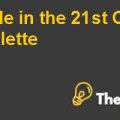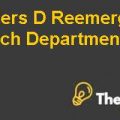Project Titan At Northrop Grumman Case Study Solution
Advantages
Contracts with US Navy:
One of the major source of revenues in the shipbuilding segment is the US Navy that purchase a large part of the production. US Navy being a potential buyer along with a public organization provides certain benefits to NOC in form of tax reductions, political backing etc. These benefits could be lost by the firm if it decides to sell the assets.
Cash Contribution:
Another advantage of spin-off is that the option would provide a continuous cash flows to NOC if it is managed in an efficient way as compared to the onetime cash inflows in the selling opting.
Profit Sharing:
Moreover, under the spin-off, the company is not required to share its returns with potential buyers as in the case of sale. Spin-off provides all of the returns to the company rather than to an outsider.
Effective Management:
The spin-off, with the selection of Petters as CEO and Barbara Nil and as CFO, both having 20 year experience, could result in better and efficient management of the new firm and improvise the financial performance of the new firm that would ultimately increase the shareholders’ wealth.
Disadvantages
New Debt Structure:
The spin-off would bring new debt I the capital structure of the new firm that increases the financial leverage of the firm and threats the financial viability of the whole company in long run. In comparison the sale option would result in the transfer of debt form the firm to the buyer.
Risks:
Another major disadvantage of the spin-off option is the risk attached with the option related to the cash flows. As the segment has been the most volatile segment of the firm with highly volatile operating profit margins, the financial position of the firm after spin-off is uncertain which ultimately reduces the worth of its shares.
Sale Divesture
The sale option for the divesture includes the sale of the assets to private equity firms at a purchase price of $2850 including 70% debt and 30% equity at an expected return for the sponsors of 20%. The option could be evaluated on the basis of certain advantages and disadvantages that are discussed below;
Advantages
Transfer of Liabilities:
One of the major advantage of the sale is the transfer of liabilities. The debt attached with the shipbuilding capabilities would be ultimately transferred to the potential buyers after sale that could not be happened under the spin-off. The transfer of liabilities increases the equity value of the firm which could lead to an increase of the shareholders’ wealth.
Repayment of Liabilities:
Another major advantage of the sale of firm is that the private equity investors are expected to increase the EBITDA Multiple from four to 5 during the initial 5 years with the repayment of all of the debt of the firm. This would allow the shareholders to earn substantial amount of money in future.
Increase in Capital Gain:
Various financial analysts seem the sale option to trigger capital gains at NCO. The capital gains could be acquired by selling the assets to potential financial buyers that would ultimately generate value for shareholders.
Disadvantages
Less potential buyers:
One of the major disadvantages of the sale option is the viability of low number of potential buyers due to the political and environmental restrictions over the sale of shipbuilding capabilities. These restrictions eliminate the potential buyers that could provide high returns to the firm.
Profit Sharing:
Another major disadvantage is in terms of sharing profits of the shareholders with the financial buyers. The private equity firms are supposed to purchase the assets at a return of 20% that would result in the reduction of the total value of the shareholders.
Analysis of the NOC Spin-off Decision
From the above qualitative and quantitative analysis of both of the alternative choices it could be said that the NOC made the right choice in pursuing spin-off rather than the sale. As spin-off would enable the company to continue contracts with US Navy with a continuous cash flow streams for the company. Moreover, the firm could utilize the efficient management that has been selected to improvise the financial position of the company. Along with it, as stated above, the spin-off would provide a high value to shareholders with a high equity value than the sale option. It would also generate potential cash flows for NOC on a continuous basis with high discounted cash flows than the sale option.
Analysis of Various Aspects of HII
With the analysis of the structure of the new firm provided in the case Exhibits, it could be seen that at the end of the structuring process, the HII would be an entire independent firm with two subsidies under management. Although, this structure provides, more flexibility to the new firm’s structure with the independence of managing various aspects of the firm, but, it poses a threat of failure for the new firm with new management.
At the time of spin off, projected enterprise value of HII will be 4.5 to 5 times EBITDA and 8.4 million debt. The HII debt to equity ratio will be 4% which means that after spin-off, company will be able to generate enough cash to meet its debt obligations. According to Exhibit 9, change in working capital will be negative in coming years which will increase the cash flows of the company.
With the analysis of the financial projections of the firm provided in the Exhibit 9, it seems that the projections are not reasonably considered. As the segment has a historical background of highly volatile profits, the firm could have assumed a conservative approach for the projections to evaluate the current enterprise value.
Conclusion
On the basis of above analysis, it could be said that divestment of the shipbuilding business is worthy because the shipbuilding segment is only the no profitable segment of the firm, so by separating the shipbuilding segment from the firm could increase the overall value of the firm. The net equity value for shareholders is $2,291 and $2,231 under spin-off and sales divesture respectively. Net equity value is high under spin-off divesture as compared to the sales divesture. It would also generate potential cash flows for NOC on continuous basis. At the time spin-off debt is considered to be $8.4 billion and $2,291 equity so, the debt-to equity ratio will be 0.0366. The spin-off option for divesture is considered to be more worthy for the shareholders of the firm but the approach adopted for projecting cash flows and deciding various aspects of the new firm must be conservative keeping in mind the historical performance of the segment in order to save the shareholders form any kind of uncertain events.
Appendix
Calculations of Cash Transfer
| Discounted Cash Transfers to NOC | |||||||
| Discount Rate (US Inflation Rate 2011) | 3.16% | ||||||
| 0 | 1 | 2 | 3 | 4 | 5 | 6 | |
| Cash Flows: | |||||||
| Sale | $ 2,213 | ||||||
| Spin off | 300 | 298 | 497 | 715 | 1137 | 1447 | |
| Discounted Cash Flows: | |||||||
| Sale | 2213 | ||||||
| Spin off | 300 | 298 | 497 | 715 | 1137 | 1447 | |
| Total Cash Transfers: | |||||||
| Sale | $ 2,213 | ||||||
| Spin off | $ 4,394 | ||||||
This is just a sample partical work. Please place the order on the website to get your own originally done case solution.










